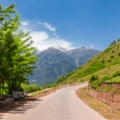India’s Golden Triangle Tour, Starting from Delhi: A Complete Guide

India’s Golden Triangle Tour is one of the most popular and cherished travel routes for anyone visiting the country. This famous circuit connects three iconic cities: Delhi, Agra, and Jaipur, offering a perfect blend of history, culture, architecture, and adventure. Whether you’re a first-time traveller to India or someone looking to dive deep into its rich heritage, this tour covers it all. Starting from the vibrant capital of Delhi, you journey through the Mughal splendour of Agra before immersing yourself in the royal grandeur of Jaipur.
But what makes the Golden Triangle so special? It’s the way these three cities encapsulate India’s diversity. From Delhi’s bustling streets filled with ancient monuments to Agra’s world-renowned Taj Mahal, and finally, Jaipur’s regal Amber Fort and Pink City charm—this journey is a sensory overload in the best possible way.
In this comprehensive guide, we’ll take you through each city, covering must-see attractions, travel tips, and how to make the most of your trip with the ideal Golden Triangle Tour itinerary.
In this Blog
Why is it Called the Golden Triangle?

The Golden Triangle gets its name from the triangular shape formed on the map by these three cities. Covering roughly 720 kilometres, this route forms an equidistant triangle that provides a rich tapestry of India’s historical evolution. The journey unveils the Mughal, Rajput, and British colonial influences that have shaped modern India.
First Stop: Delhi – A Fusion of Modern and Ancient
Delhi, India’s capital, is a city of contrasts. From modern skyscrapers and bustling marketplaces to ancient Mughal and British architecture, Delhi presents a unique blend of the old and the new.
Must-Visit Places in Delhi:
Red Fort: A symbol of Mughal power, this UNESCO World Heritage site offers a glimpse into India’s grand past. (One of the top tourist attractions in Delhi)
Qutub Minar: A 73-meter-high minaret, it stands as one of the oldest structures in Delhi.
India Gate: This war memorial honours the fallen soldiers and is a symbol of national pride.
Humayun’s Tomb: The stunning tomb of the Mughal Emperor Humayun, is often considered a precursor to the Taj Mahal.
Lotus Temple: Known for its unique lotus-like shape, this temple is a marvel of modern architecture.
Pro Tip: If you’re visiting Delhi in winter, you’ll love the cooler climate, which makes sightseeing much more comfortable. Some of the best places to visit in Delhi during winter include Lodhi Gardens, Jama Masjid, and the vibrant shopping areas of Connaught Place.
For those interested in venturing outside of the capital, there are several places to visit near Delhi, such as Neemrana Fort Palace, Sultanpur Bird Sanctuary, and the Tughlaqabad Fort.
Stay in Delhi: For an authentic experience, stay at one of the cosy homestays in Delhi, offering a local flavour and warm hospitality in key areas like South Delhi and Connaught Place.
Second Stop: Agra – Home to the Majestic Taj Mahal
No Delhi Agra Jaipur tour is complete without witnessing the beauty of the Taj Mahal in Agra. Agra, a city steeped in Mughal history, offers more than just the Taj Mahal; it’s a treasure trove of architectural wonders.
Must-Visit Places in Agra:
Taj Mahal: Described as the “epitome of love,” this white marble mausoleum is a UNESCO World Heritage site and one of the New Seven Wonders of the World.
Agra Fort: Another UNESCO site, this fort served as a royal residence and military base during the Mughal era.
Mehtab Bagh: Offering panoramic views of the Taj Mahal, this garden is perfect for capturing stunning photographs.
Fatehpur Sikri: Just an hour from Agra, this ancient city was once the capital of the Mughal Empire and is home to several well-preserved structures.
Pro Tip: Visit Agra in December or Agra in winter to enjoy cooler temperatures and fewer crowds at the Taj Mahal. Sunrise at the Taj Mahal is a magical experience. Arrive early to witness the monument bathed in the soft, golden light of dawn. The distance from Delhi to Agra is around 230 kilometres, making it a comfortable road trip or train journey.
Stay in Agra: For a luxurious stay, opt for one of the elegant villas in Agra that offer comfort and stunning views of the Taj Mahal, enhancing your Agra experience.
Third Stop: Jaipur – The Pink City of Royalty
Jaipur, the capital of Rajasthan, is often called the Pink City for its trademark rose-coloured buildings. It’s a city that oozes royal charm, with opulent palaces, massive forts, and colourful bazaars that will take you back in time.
Must-Visit Places in Jaipur:
Amber Fort: Overlooking Maota Lake, Amber Fort is a massive structure that showcases the grandeur of Rajput architecture.
City Palace: Located in the heart of Jaipur, this palace is still the residence of the royal family and is a perfect blend of Mughal and Rajput styles.
Hawa Mahal: Known as the Palace of Winds, this unique five-story building with over 900 windows was designed to allow royal ladies to observe street festivals unseen.
Jantar Mantar: This UNESCO World Heritage site is an astronomical observatory built by Maharaja Jai Singh II and is a must-visit for science and history buffs.
Pro Tip: Visit Jaipur in winter or Jaipur in December to avoid the intense summer heat. The cooler weather is perfect for exploring the Pink City. For a quieter visit, Jaipur in November is also a great option. Don’t miss out on shopping at the bustling Johari Bazaar and Bapu Bazaar.
Stay in Jaipur: Stay in one of the heritage villas in Jaipur for a royal experience. These villas offer a taste of Rajasthani opulence, complete with traditional decor and modern amenities.
Best Time to Visit the Golden Triangle
The best time to embark on the Golden Triangle Tour is between October and March, especially if you plan to visit Delhi in winter when the weather is pleasant and ideal for sightseeing. Summers in North India can be extremely hot, while winters offer cool mornings and sunny afternoons, perfect for exploring the best places to visit in Delhi, Agra, and Jaipur.
How to Travel: Navigating the Golden Triangle
By Road: You can easily hire a private car or take buses to travel between the cities. The distance from Agra to Jaipur is around 240 kilometres, while Jaipur to Delhi is approximately 270 kilometres.
By Train: India has an extensive railway network. Trains like the Gatiman Express and Shatabdi Express are fast and comfortable options for travel between Delhi to Agra and Agra to Jaipur.
By Air: Jaipur has an airport, so you can fly back to Delhi after completing your tour, saving time.
For those looking for a more structured trip, several Golden Triangle Tour packages are available, offering guided tours and transportation. Whether you choose a Golden Triangle package itinerary for 4 nights 5 days or a Golden Triangle tour itinerary for 3 nights 4 days, you’ll find options to suit every budget and schedule.
FAQs for First-Time Travelers
1. Is it safe to travel the Golden Triangle?
Yes, the Golden Triangle is one of the safest tourist circuits in India, especially for solo travellers. Just follow basic travel precautions.
2. How long should the tour be?
A 5-6 day trip is ideal for exploring all the major sights without rushing. Many tour operators offer a Golden Triangle tour itinerary for 4 nights and 5 days, but you can customize your trip to suit your schedule.
3. What should I pack?
Comfortable walking shoes, sunscreen, and light, breathable clothes are essential, especially if you’re visiting in summer.
Embark on Your Golden Triangle Adventure
The Golden Triangle Trip offers a window into India’s soul. From the bustling streets of Delhi to the serene beauty of the Taj Mahal and the royal allure of Jaipur, this journey will leave you with memories for a lifetime. Whether you’re a history buff, a culture enthusiast, or someone who loves a good adventure, the Golden Triangle has something for everyone.
So, if you’re ready to experience the magic of India, start planning your Golden Triangle Tour today!





